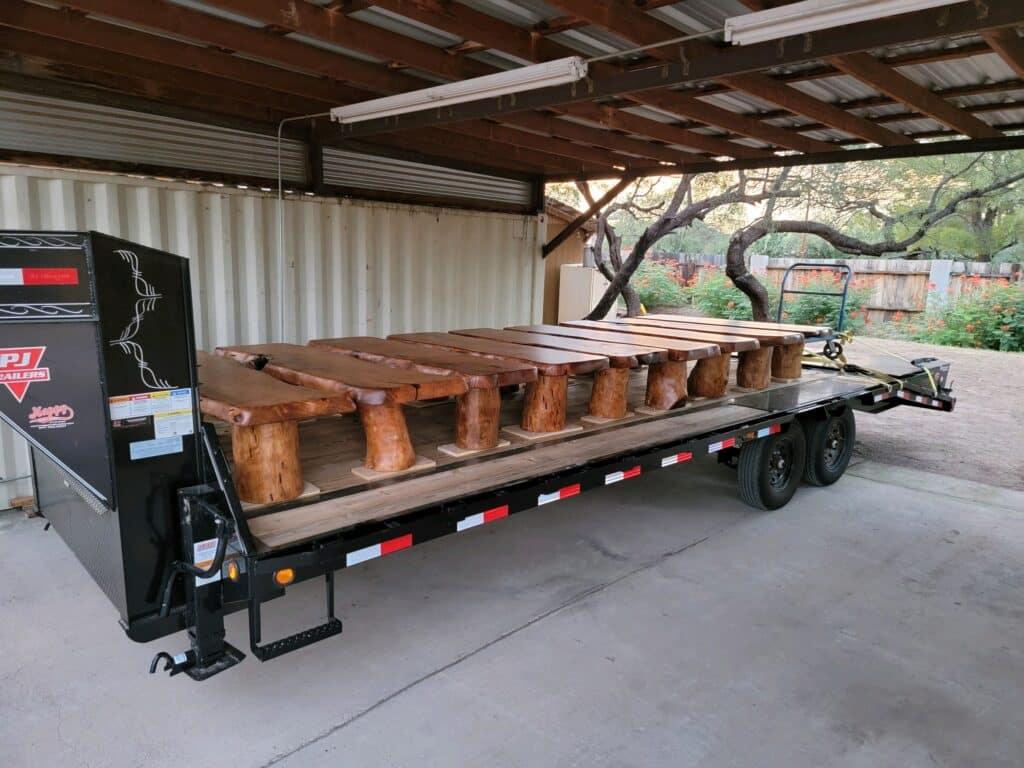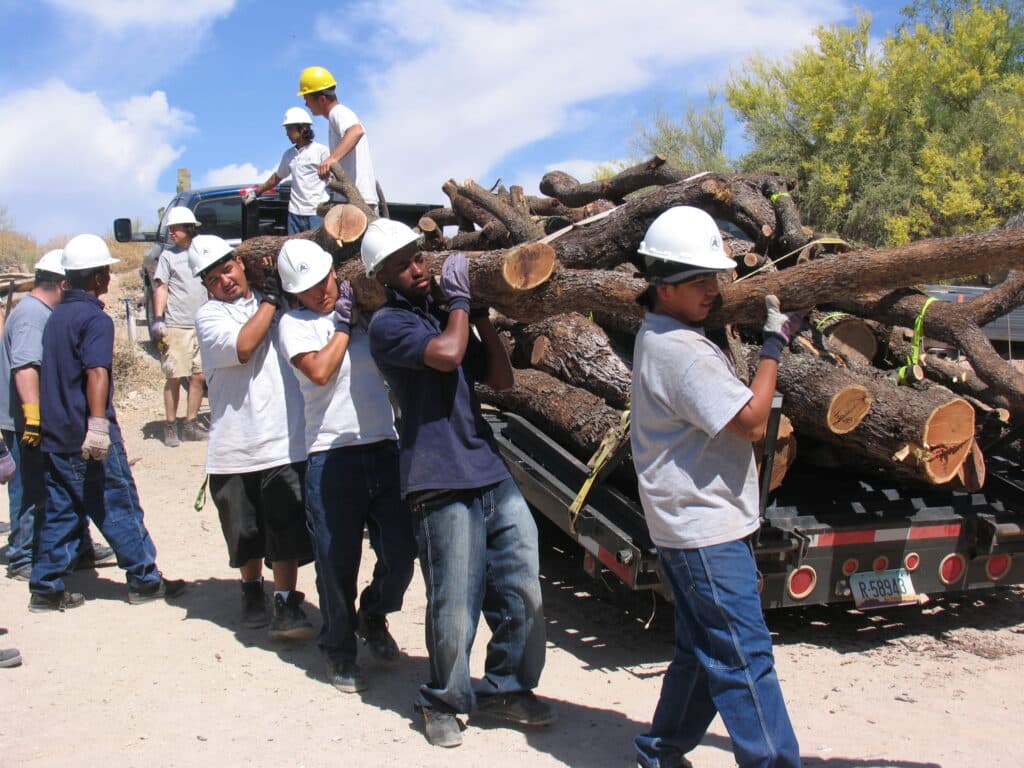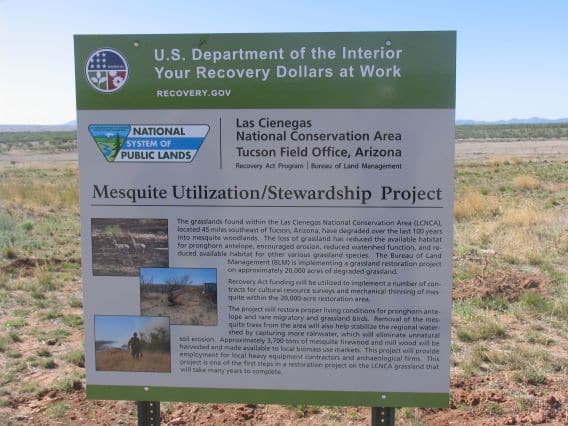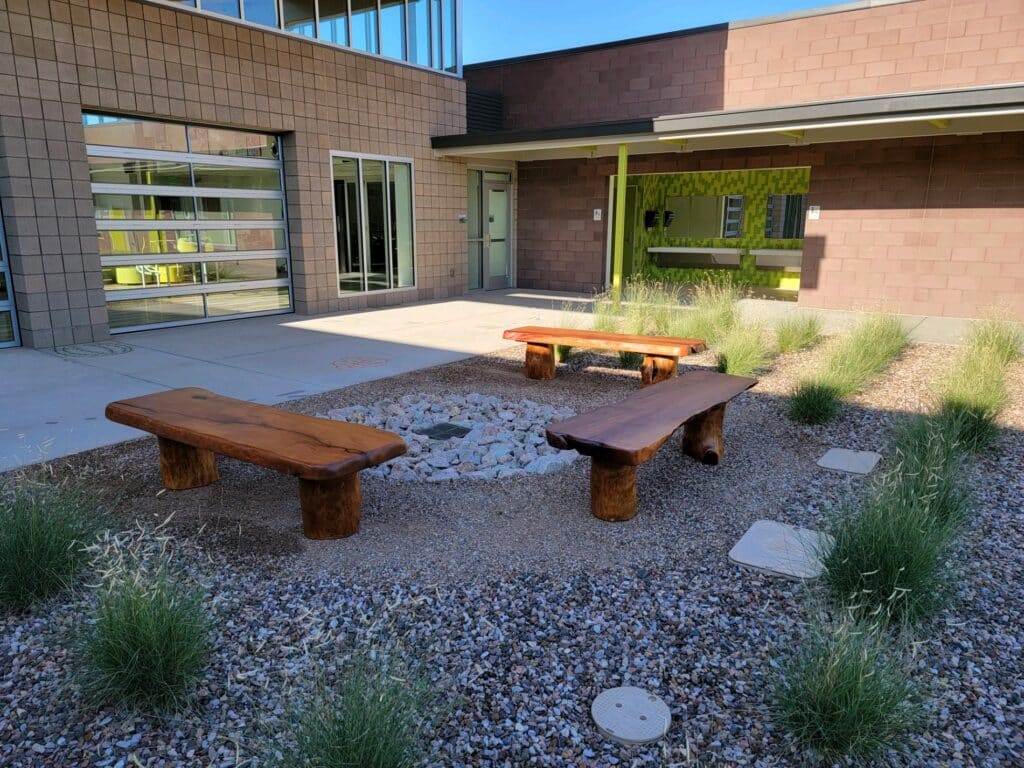Tumacacori Mesquite Sawmill in Tumacacori-Carmen, Arizona gives mesquite trees a second life.
Art and Valerie have owned and operated the sawmill for over 20 years. Their work gives renewed purpose to trees that need to be cut down and that otherwise would be discarded.
“What I like about this business is that we are doing things that are creative. We’re not taking a product that’s plentiful and cut and pasting things to make an end product. Mesquite is imperfect because it grows in the desert. The conditions in the desert are pretty adverse, so it grows crooked and cracked. We source mesquite that’s going to be taken down anyway and do something creative with it,” Art explains.

Benches featuring the natural characteristics of mesquite.
Many of Art and Valerie’s finished creations go into public interest locations.
“There are attractions in southern Arizona that have our finished products because these are really the essence of the southwest and people love to see it,” Art says. Their work can be found in venues like historical churches, the Desert Museum, and the Tohono O’odham Nation Culture Center and Museum.
They have also helped to restore parts of the San Xavier Del Bac Mission, which was built in the late 1600s, by replacing some of the mesquite that has degraded over the years. “The wood we’ve milled has been used to repair the bell towers, balconies, corbels, and doors,” Art says.

One of the balconies they helped to restore.
Respecting Indigenous Culture
Valerie is of Navajo descent and says that mesquite has been used by Indigenous Peoples for a long time.
“In Arizona, there are over 20 Native American tribes and the tribes that use mesquite the most is Tohono O’odham and the Pascua Yaqui tribe. They’ve incorporated a lot of the uses of the mesquite. They use the roots, the bark, the tree, and even the pods which they grind down for flour,” Valerie says.
She says mesquite is important to the Navajo as well.
“During the Long Walk, the Navajos dug up mesquite root when they were forced to move from their land to a militarized area called Fort Sumner. It was a treacherous time for the Navajo people in the mid-1800s. They had to walk through the desert and there weren’t a lot of trees but the mesquite root saved a lot of lives because they used it for heating purposes and cooking. It’s a hard wood so the heat from it is long-lasting,” Valerie explains.
In keeping with those traditions, Art and Valerie try to use every part of the tree.
“Everything we bring back we use. Even the sawdust has been used for organic farming by a local organic farm. They use it in gardening and bedding. Remnants are used to make cutting boards and crosses that we sell in our gallery,” she explains.
They also bring some wood back to her hometown for Elders to use as firewood in the winter months.
Responsible Harvesting and Salvaging
Art and Valerie’s business relies on wood, but they feel strongly about only using trees that had to come down anyway.
“We like to think that we’re doing something responsible,” Art explains. When they hear that trees are being cut, as can happen with construction projects, they reach out to the people taking down the trees to see if they can be salvaged.
“We don’t go in there and just start cutting trees. These trees are in riparian areas, conservation areas, and private property. So we don’t over-market what we have because there isn’t an abundance of mesquite out there. But over the past 21 years, we’ve found that there’s a balance between the supply, the capacity we have at the sawmill, and the demand the market will bear,” he explains.

Salvaging mesquite wood.
Recently, Art and Valerie connected with Pattern Energy to do just this.
“In the low-lying areas, like where Pattern is going to run their electric lines through in the San Pedro River basin, there is a lot of water underground. Once mesquite trees tap into this water source, they can get pretty sizable,” Art says.
As trees are removed, Art and Valerie will collect as much of the mesquite as possible and will turn it into functional and creative pieces.
Environmental Impact
In the early 2000s, Art and Valerie participated in the Mesquite Utilization/Stewardship Project administered by the Bureau of Land Management in the Las Cienegas National Conservation Area in Arizona.
“This area was mostly rolling grassland. The mesquite was isolated to low-lying drainage areas and it wasn’t growing everywhere the way it is today,” Art says. The proliferation of cattle in the area over the last 150 years has accelerated the spread of mesquite. Cattle eat the mesquite seed pods, which get distributed across the landscape in an ideal fertilizer: cow dung. “This has changed the ecosystem because now the mesquite is everywhere,” Art explains.
Because the mesquite soaks up the groundwater and creates shade, it suppresses the growth of the grass.

A description of the project. Photo credit: Tumacacori Mesquite Sawmill
“This effort was designed to thin out the mesquite and to restore the natural grasslands. We were brought in to remove the aboveground biomass, weigh it, and bring it back to the sawmill,” Art says.
Truly Handmade

Handmade benches made from mesquite.
When it comes to creating something from the wood, Valerie says the possibilities are endless.
“Art is the designer for everything we make,” Valerie explains. “When someone comes in, they’re basically driving the show for what they’re looking for. What’s unique about the sawmill is that a customer can present their vision to Art and become part of the process from start to finish. Once designed, Art brings the design to our small manufacturing team.”
They’re involved in all of the steps before the design stage, from locating the wood to harvesting it, turning it into lumber, designing, crafting, delivering, and installing. Valerie says each step in the production process is done by hand.
Working with Pattern Energy
Pattern Energy’s Senior Manager of Environmental Compliance & Strategy, Chase Taylor, says Tumacacori Mesquite Sawmill will be able to start salvaging wood this summer as cuttings are made along the SunZia Transmission corridor.
He says working together with Art and Valerie closely aligns with Pattern’s values.
“Pattern’s vision of decarbonizing America’s grid, through building critical green energy projects, all while minimizing impacts to our environment, remains a contiguous focus on the SunZia project and elsewhere. The years of studies, partnership, and community and stakeholder engagement that it takes to get a project like this off the ground, can seem insurmountable. On SunZia, the focus continues to remain around minimizing impacts to the environment,” Chase explains.
He’s looking forward to working more with them and seeing what they make from the mesquite.
“When Art and Valerie reached out to me I felt a connection to this project immediately and had a strong desire to see this opportunity through for them, for Pattern, and out of respect for the resources. The hurdles that sometimes have to be jumped through in order to see a valuable and unique project like this come to fruition, can be daunting. But with patience from Art and Valerie and due diligence internally and with project partners, we were able to make this come to life,” he says.
Learn more about the work of the Tumacacori Mesquite Sawmill by visiting their website: https://www.mesquitedesign.com/.